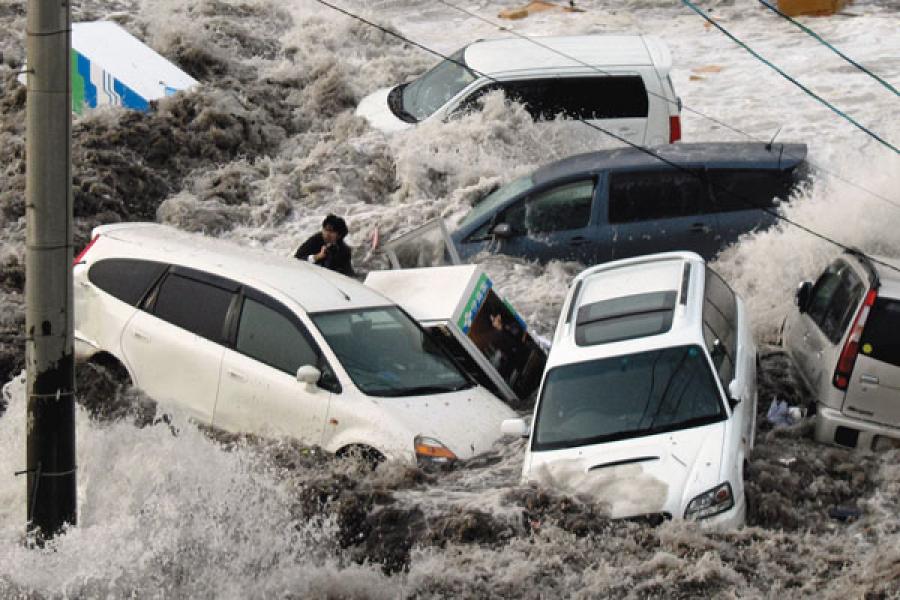
Rebirth of Japan
It is not enough to rebuild. This is the occasion for Japan to revisit its spirit of naturalism
I mamichi Tomonbu, Japan’s renowned philosopher, once wrote, “The Sea is a symbol of the infinite god. A person is just a drop of froth that disappears in the crest of a wave.” Towards the close of the 13th century, the infinite god let loose its typhoons to devastate Kublai Khan’s armada. This helped Japan’s Samurais protect the islands from the invading Mongols. Seven centuries later the Samurais were gone and Japan found herself constantly threatened by typhoons and tsunamis.
What Happened?
By the 1970s, the world’s economic powerhouse had shifted the bulk of her industrial civilisation perilously close to its coastlines. This was when Japan started viewing the giant tsunamis as forces of mass destruction. Since then, Japan’s efforts to ward off nature’s fury intensified. The nation’s prowess with nimble technologies was equally matched by its feats in structural engineering. For many decades, engineers worked furiously to insulate Japan’s coastal cities from earthquakes and tsunamis. They created wonders — a ‘second nature’ — in the shape of reclaimed lands, artificial beaches, earthquake-proof buildings and to top it all, giant sea walls along the shores.
Indeed, when it came to sea walls, Japanese technology excelled in its efforts to re-create nature. Facing criticism about the non-ecological properties of sea walls, Japanese engineers constructed block-shaped slanting sea walls to help sea turtles lay eggs. Everyone watched with glee when turtle egg drops soared in numbers alongside the new structures. Later on, when protests mounted against sea walls for denying coastal denizens their morning walk, the engineers designed sea walls with flat tops to stroll on. I had the occasion to see these structures in the late 1990s.
On March 11, the tsunami wave pole vaulted the tall walls to immobilise the generators that supplied power to cool nuclear reactors. As the fuel rods in the nuclear power stations melted, so did the Japanese dream run with structural technologies. The country’s disaster management system was thrown off gear. Notwithstanding the stoic resolve of Japan’s brave citizens, it needed Emperor Akihito to provide the soothing touch. The Emperor exhorted his subjects to bravely weather the crisis. It was not the voice of power — it was the voice of a sublime authority that silently wept at his people’s plight.
In the wake of the latest tragedy there have been other signs of a toss-back to the past. The Kamikaze idea was re-invented, this time as electrical engineers and their workmen who braved radiation rays in their efforts to get the affected nuclear power plants on rails and save the nation from its second nuclear holocaust.
From time to time, major natural disasters have temporarily pushed the Japanese clock away from modernity. And the flight to the past was lead by Japan’s writers and intellectuals. The infamous Kanto earthquake of 1923 that destroyed Tokyo and Yokohama and pushed the Giant Buddha of Kamakura dangerously close to the rim of the Pacific Ocean, created a major cognitive rupture for the Japanese society. Junichiro Tanizaki, the nation’s greatest novelist after Natsume Soseki and a victim of the 1923 quake, left his shattered home in Yokohama and migrated to Kansai. Tanizaki also left behind his endless fascination for the Western way of life. He probed the inner recesses of Japanese mysticism and traditional performing arts, notably the Noh and the Kabuki. The result was his discovery that modernity with a Japanese touch was the golden mean.
It is not enough that Japan rebuilds and restores. Japan must be reborn with all the splendour of its golden mean. This is the occasion to revisit its spirit of naturalism, symbolised by its homes. They are austere and use energy minimally. Ironically, when it came to its industrial civilisation in coastal cities, Japan went in the opposite direction — packed spaces, opulent structures, sea walls and installations that consumed large loads of nuclear power.
Tsunami victims like India have two lessons to learn from Japan’s experience: That there are limits to how much engineering can do to ward off natural disasters and that it pays to encourage decentralised approaches to managing coastal areas. The latter approach is inclusive, naturalistic and sustainable.
A. Damodaran teaches at the Indian Institute of Management, Bangalore, and is the author of the book Encircling the Seamless: India, Climate Change and the Global Commons
(This story appears in the 06 May, 2011 issue of Forbes India. To visit our Archives, click here.)















